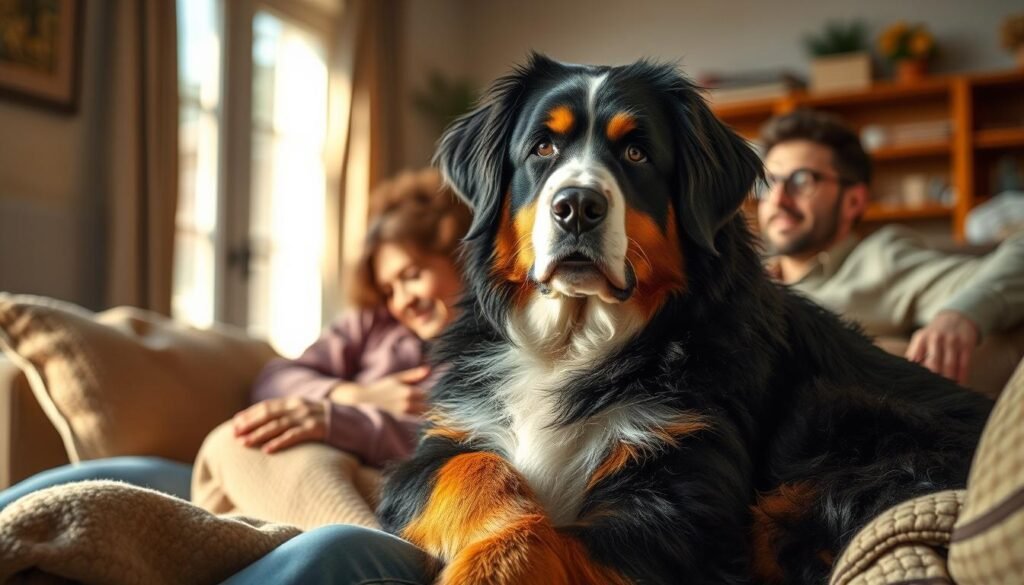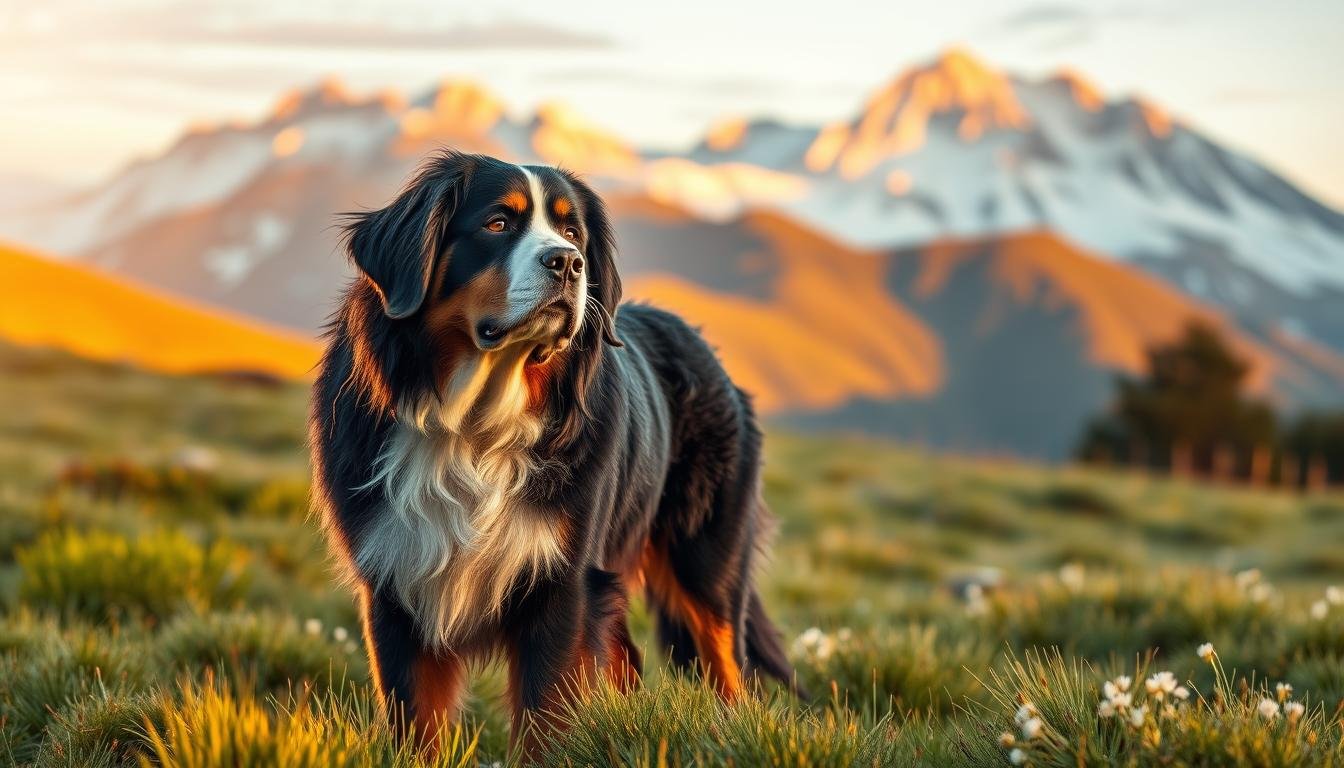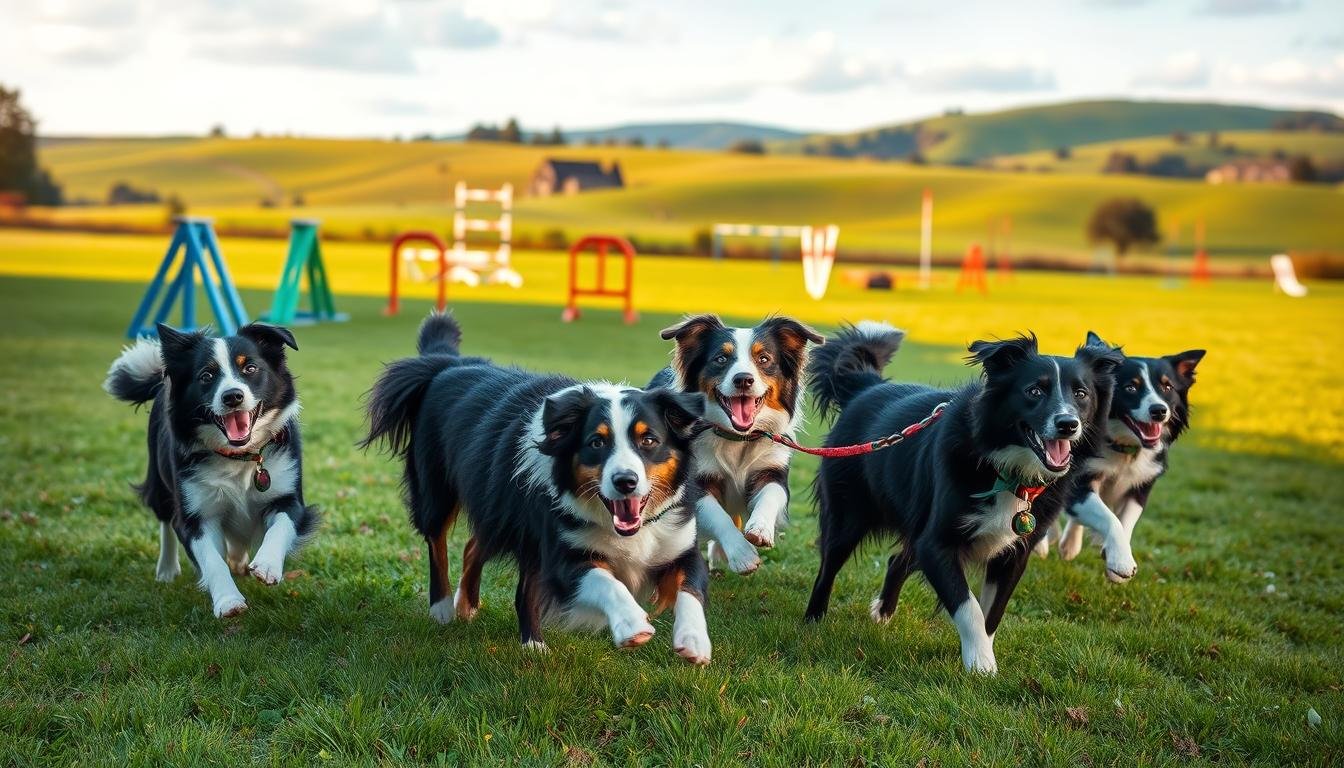Ever wondered how a four-legged friend could become both a farmhand and a couch connoisseur? Picture this: rolling Swiss hills dotted with fluffy tri-colored helpers hauling milk carts by day and warming children’s feet by night. That’s the magic we’re unpacking today—a story where loyalty isn’t just earned, it’s bred into every paw print.
Two millennia ago, Roman soldiers marched through Alpine passes with large, sturdy canines by their side. These weren’t just pets—they were partners in survival. Fast-forward a few centuries, and their descendants became the Swiss farmer’s right-hand “paw,” herding cattle and guarding homesteads with quiet confidence. Talk about a career glow-up!
What makes this tale so special? It’s not just about survival or strength. It’s about a creature that mastered the art of balancing brawn with heart. Their signature coat isn’t just fashion—it’s a walking history lesson in black, rust, and white. And that gentle gaze? Let’s just say it’s been melting hearts since before the invention of chocolate fondue.
Key Takeaways
- Origins trace back to Roman-era working dogs in the Alps
- Evolved from military companions to essential Swiss farm helpers
- Distinctive tri-color coat serves as living historical evidence
- Natural work ethic seamlessly transitioned to family life
- Maintained core traits through centuries of adaptation
- Combines physical strength with unusually gentle temperament
The Captivating Origins of the Berner
What happens when Roman war machines meet Alpine ingenuity? You get a four-legged revolution. Two thousand winters ago, soldiers trudging through snowy passes relied on massive canines to haul armor and cheese wheels up slopes steeper than a toddler’s tantrum.
Tracing Roman Roots and Alpine Journeys
Legions marching from Italy to Spain bred Mastiff-like beasts with local black-and-tan road warriors. These prototypes could pull carts weighing triple their size while keeping watch for avalanches – multitasking before it was trendy. Through strategic pairings, they created a canine all-rounder built for altitude and attitude.
Early Roles on Swiss Farms
When peace replaced conquest, these adaptable working partners found new purpose. Around Bern’s lush midlands, they became dairy maestros – hauling milk churns by dawn and herding cattle by dusk. Farmers called them Sennenhund, but we’d dub them “Swiss Army dogs” for handling everything from guarding cottages to transporting textiles.
Basket weavers particularly adored their furry colleagues. Picture wagons piled high with woven goods, steadied by steady paws on narrow mountain paths. No GPS needed – just trusty instincts and that iconic tri-color coat blending into alpine sunsets.
bernese mountain dog history: From Swiss Farms to U.S. Recognition

What does it take to rescue a breed from obscurity? Imagine tractors replacing furry draft teams, steel crates overshadowing wagging tails. By the 1880s, these alpine workhorses faced extinction – until a few stubborn romantics rewrote their fate.
Historical Breeding and Heritage Insights
Franz Schertenleib didn’t just walk Swiss valleys in 1892 – he went on a canine treasure hunt. His quest? To find remaining purebred specimens before industrialization erased their legacy. This revival birthed the first specialty club in 1907, cementing standards that honored their pastoral roots.
Revival Efforts and AKC Milestones
Kansas farmers got a Swiss surprise in 1926 when Isaac Schliess imported the first pair. But Louisiana’s Glen Shadow one-upped them – his 1936 imports Felix and Fridy later tackled a charging buck like furry linebackers. Their heroics proved these breeds weren’t relics, but living legends.
| Year | Milestone | Impact |
|---|---|---|
| 1937 | American Kennel Club Recognition | Official U.S. breed status |
| 1968 | BMDCA Formation | Preserved drafting traditions |
| 1926 | First U.S. Imports | Midwest introduction |
The kennel club seal of approval in 1937 wasn’t just paperwork – it was a transatlantic high-five between Swiss heritage and American dog lovers. Today’s carting competitions? That’s the BMDCA’s genius move to keep their trucker-dog DNA alive and kicking.
Working Life and Drafting Adventures
Who says you can’t teach an old breed new tricks? Today’s descendants of Alpine haulers swap cheese carts for competition courses, proving their working dog DNA remains sharper than a Swiss Army knife.
Drafting, Carting, and Modern Canine Sports
Meet Julie Bacon’s superstar trio – Indie, Moxie, and Trip. These overachievers in fur coats hold Grand Master Draft Dog titles while crushing agility courses. Indie made history as the first of her group to earn the Master Agility Champion crown. Not bad for a breed that once considered milk churns their main gym equipment.
Modern drafting tests mirror ancestral chores. Competitors pull 20-pound carts half a mile in 12-15 minutes – basically a furry CrossFit session. But there’s science behind the sweat: dogs can’t haul weight until their growth plates fuse around age two. Smart trainers start with harness introductions at six months using training wheels, because even work heroes need safety gear.
Performance Highlights & Training Tips
Their secret sauce? Biddability meets brute strength. These eager athletes will try anything – including water sports that defy their landlocked heritage. “They’re the overachievers of the mountain dogs world,” says Bacon. “Give them a challenge and watch those tails wag like metronomes.”
| Test Component | Requirement | Purpose |
|---|---|---|
| Distance | 0.5 miles | Mimics historical farm routes |
| Time Limit | 12-15 minutes | Tests endurance & pacing |
| Cart Weight | 20 lbs average | Simulates milk/cheese loads |
| Age Minimum | 24 months | Protects developing joints |
From agility tunnels to drafting courses, these working dogs thrive when mixing brain and brawn. Pro tip: Keep sessions short – their attention spans last about as long as a melted Toblerone. But when motivated? They’ll work harder than a cuckoo clock mechanic during peak tourism season.
Family Companionship and Everyday Charm

Who needs a security system when your furry roommate doubles as a living teddy bear? These gentle giants have perfected the art of being simultaneously imposing and irresistible. Their secret lies in that magical combo of size and sweetness – like having a black-and-rust polar bear who thinks they’re a lap cat.
Loyalty on the Home Front
Georgeann Reeve’s pack once retrieved drifting boogie boards like furry lifeguards. “They’re born mediators,” she laughs. “Mine break up sibling squabbles by plopping 90 pounds of fluff between arguing kids.” The AKC breed standard confirms this duality – males tower up to 27.5 inches yet move with the grace of ballet dancers chasing tennis balls.
Their coat maintenance? Think of it as spa days with benefits. Weekly brush-outs keep that signature tri-color glory Instagram-ready while reducing tumbleweeds of fur. Bonus: Their weatherproof fur turns snow days into photo ops. Just try resisting those snow-dusted eyebrows!
Despite their family-friendly rep, these athletes need moderation. A leisurely hike satisfies their exercise cravings better than marathon training. Cold-weather strolls? They’ll outlast your winter boots. Warm days? Let’s just say they’re more “porch supervisors” than jogging buddies.
The true magic happens at home. Whether serving as oversized foot warmers or supervising homework sessions, they redefine “man’s best friend” as “family’s favorite therapist”. Their size commands respect, but their heart? That’s what turns houses into homes.
Conclusion
Few creatures bridge past and present like these Swiss icons. Originally bred as farm dog companions, they mastered the art of being both sturdy workers and soft-hearted guardians. Their days once revolved around milk cart routes and keeping watch over cattle—no Swiss Army knife ever multitasked better.
Modern dog breeds rarely maintain such perfect duality. Yet here they stand—equally at home in draft competitions or draped across couches. Early farmers prized their calm alertness, a trait that now makes them ideal family partners. Those soulful eyes? They’ve been disarming strangers since before cheese fondue became a national dish.
Breed revivalists didn’t just save a species—they preserved living history. Today’s dog clubs honor this legacy through events that echo Alpine traditions. Whether guiding children or pulling carts, these gentle giants prove some bonds only strengthen across centuries.




